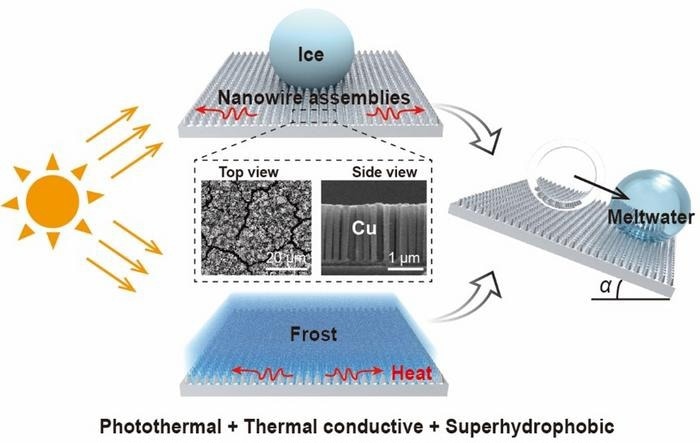Researchers at the Dalian University of Technology have constructed a design of copper nanowire assemblies that can considerably improve the defrosting and de-icing efficiency with no predictable energy input. Specifically, the defrosting efficiency reaches 100%, a record-high value compared to reported studies.
 Through the facile electrochemical method, copper nanowire assemblies were fabricated that combine photothermal, heat-conducting, and superhydrophobic properties to achieve highly efficient de-icing and defrosting. Image Credit: Siyan Yang, Qixun Li, Bingang Du, Yushan Ying, Yijun Zeng, Yuankai Jin, Xuezhi Qin, Shouwei Gao, Steven Wang, Zuankai Wang, Rongfu Wen and Xuehu Ma.
Through the facile electrochemical method, copper nanowire assemblies were fabricated that combine photothermal, heat-conducting, and superhydrophobic properties to achieve highly efficient de-icing and defrosting. Image Credit: Siyan Yang, Qixun Li, Bingang Du, Yushan Ying, Yijun Zeng, Yuankai Jin, Xuezhi Qin, Shouwei Gao, Steven Wang, Zuankai Wang, Rongfu Wen and Xuehu Ma.
The research was published in International Journal of Extreme Manufacturing. It displays a straightforward electrochemical approach for fabricating nanowire assemblies using a controlled pattern, size, and hierarchy. This facilitates the concurrent presentation of thermally conductive, photothermal, and superhydrophobic properties, which are impossible for conventional surfaces otherwise.
The photothermal property guarantees efficient sunlight absorption, the thermal conductive property bestows quick lateral heat conduction following sunlight absorption, and the superhydrophobic property forces the rolling or sliding away of frost/ice upon melting from the surface.
Frost and ice buildup pose considerable challenges in many applications.
Traditional de-icing/defrosting solutions mainly rely on mechanical, thermal, and chemical approaches, yet, all of which are either energy-intensive, labor-intensive, or environmentally unfriendly. Additionally, some of these active approaches required direct contact with the material surface, posing risks to delicate coatings. To achieve energy-saving and eco-friendly deicing/defrosting without compromising the surface functionality, most efforts have shifted towards passive approaches via surface modifications.
Siyan Yangthe Study First Author and Postdoc, Hong Kong Polytechnic University
Recent attention has focused on photothermal surfaces with superhydrophobicity that could be heated with sunlight, a green energy source. Most surfaces, however, suffer from uneven and localized heating owing to inferior thermal conductivity. Hence, further assembling such surface properties using thermally conductive materials, particularly metals, comes with a great possibility for defrosting and de-icing, which is hugely unexplored.
To address the above issues, we develop a facile fabrication approach to produce controllable copper nanowire assemblies. We found the morphology, height, and scale of the assemblies can be well tuned by adjusting the electrochemical parameters. Through wettability and photothermal tests, we found that most of nanowire assemblies can be treated superhydrophobic, with a sunlight absorption rate larger than 95%. Because of the high conductivity of copper materials, nanowire assemblies, especially the design with upright nanowires and an average microgroove width of 2-3 μm, enable superior de-icing and defrosting performances.
Qixun Li, Study First Co-Author and PhD Student, Dalian University of Technology
This breakthrough design can result in 2-3 times shorter total defrosting durations compared to the other three nanostructured surfaces with superhydrophobicity, photothermal effect, or a mix thereof. Remarkably, this design attains the highest defrosting efficiency (~100%) than the previous works.
In principle, infusing the easy fabrication, high controllability, and diversity in morphology, the design of nanowire assemblies is promising in broad de-icing and defrosting applications that remove the need for traditional energy input. However, the durability, scalability, and chemical stability of the nanowire assemblies are limited in practical applications involving complex working conditions. It is necessary to develop more general micro/nano material processing methods to improve manufacturing efficiency, material scale, and surface durability. Despite this, the design concept of this work serves as a compass for future research endeavors, especially in cold areas facing power shortage.
Xuehu Ma, Study Corresponding Author and Chemical Engineering Professor, Dalian University of Technology
Journal Reference:
Yang, S., et al. (2023) Photothermal superhydrophobic copper nanowire assemblies: fabrication and deicing/defrosting applications. International Journal of Extreme Manufacturing. dx.doi.org/10.1088/2631-7990/acef78.